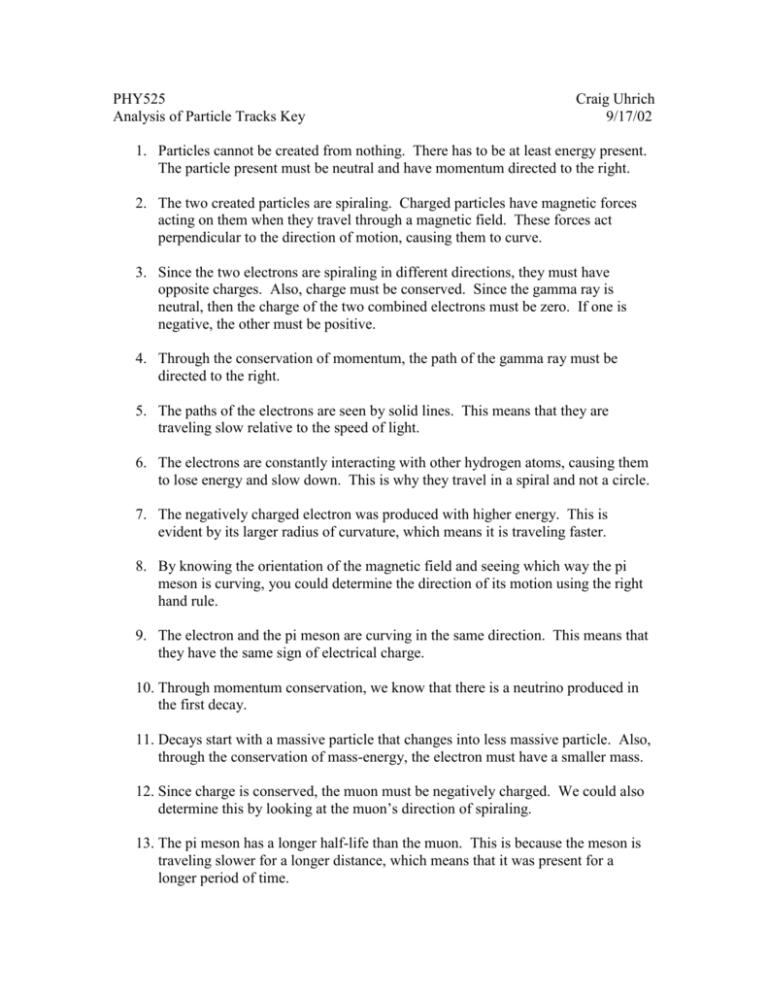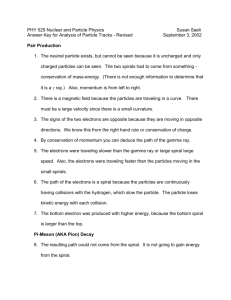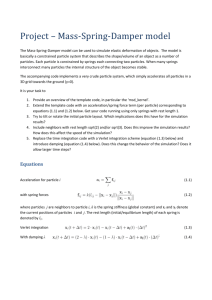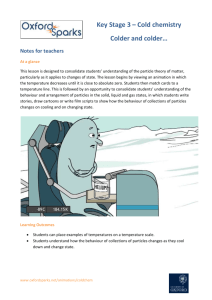UrichRevPTkey
advertisement

PHY525 Analysis of Particle Tracks Key Craig Uhrich 9/17/02 1. Particles cannot be created from nothing. There has to be at least energy present. The particle present must be neutral and have momentum directed to the right. 2. The two created particles are spiraling. Charged particles have magnetic forces acting on them when they travel through a magnetic field. These forces act perpendicular to the direction of motion, causing them to curve. 3. Since the two electrons are spiraling in different directions, they must have opposite charges. Also, charge must be conserved. Since the gamma ray is neutral, then the charge of the two combined electrons must be zero. If one is negative, the other must be positive. 4. Through the conservation of momentum, the path of the gamma ray must be directed to the right. 5. The paths of the electrons are seen by solid lines. This means that they are traveling slow relative to the speed of light. 6. The electrons are constantly interacting with other hydrogen atoms, causing them to lose energy and slow down. This is why they travel in a spiral and not a circle. 7. The negatively charged electron was produced with higher energy. This is evident by its larger radius of curvature, which means it is traveling faster. 8. By knowing the orientation of the magnetic field and seeing which way the pi meson is curving, you could determine the direction of its motion using the right hand rule. 9. The electron and the pi meson are curving in the same direction. This means that they have the same sign of electrical charge. 10. Through momentum conservation, we know that there is a neutrino produced in the first decay. 11. Decays start with a massive particle that changes into less massive particle. Also, through the conservation of mass-energy, the electron must have a smaller mass. 12. Since charge is conserved, the muon must be negatively charged. We could also determine this by looking at the muon’s direction of spiraling. 13. The pi meson has a longer half-life than the muon. This is because the meson is traveling slower for a longer distance, which means that it was present for a longer period of time. 14. The incoming proton collided with the nucleus of a hydrogen atom. The bubble chamber is filled with liquid hydrogen. 15. The proton’s track appears to be straight because it is traveling with a very high velocity. 16. The tracks of the K and lambda particles are not seen. This means that they are neutral particles. This can also be determined because charge is conserved. 17. Because momentum is conserved, we know that the K and lambda particles exist. In addition, particles are never created from nothing. 18. The pi-minus meson and the proton produced in the decay of the lambda particle must have equal and opposite charges because of charge conservation. The lambda particle is neutral, which means if the proton is positively charged, than the lambda particle must be negatively charged. 19. The lifetimes of the K and lambda particles are very short. This is seen by their short distances that they travel.







